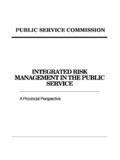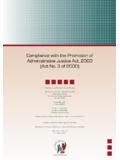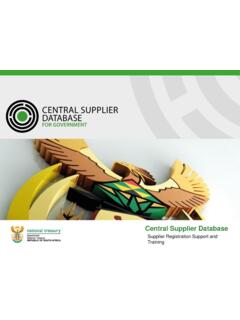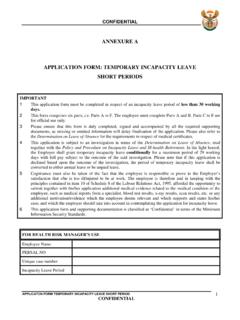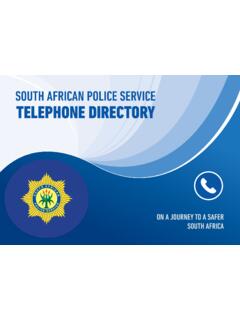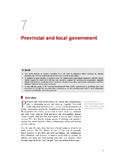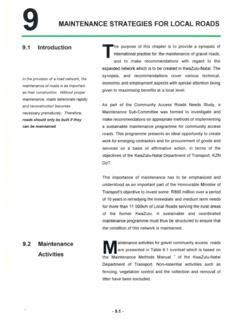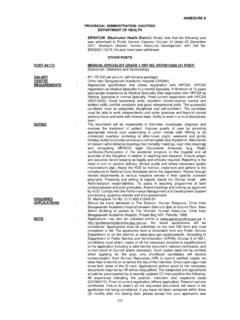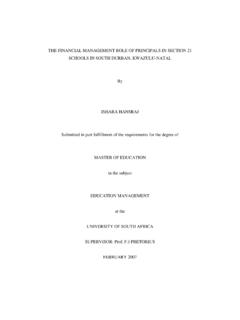Transcription of THE IMPACT OF RECRUITMENT AND SELECTION PRACTICES …
1 THE IMPACT OF RECRUITMENT . AND SELECTION PRACTICES ON. THE FUNCTIONALITY OF. SELECTED NATIONAL AND. provincial DEPARTMENTS. MARCH 2015. FOREWORD. The Constitution of South Africa provides that Public administration must be development oriented, broadly representative of the South African people and accountable. This provision further states that employment and personnel management PRACTICES must be based on ability, objectivity, fairness, and the need to redress the imbalances of the past to achieve broad representation. To achieve this and also ensure that the country can address the twin challenges of poverty and inequality, the National Development Plan 2030 calls for a State that is capable of playing a transformative and developmental role. This will require well run and effectively coordinated State institutions staffed by skilled public servants who are committed to the public good and capable of delivering consistently high quality services for all South Africans.
2 Government's ability to address the developmental challenges depends on its ability to recruit, select and retain highly competent staff across all levels. This therefore makes RECRUITMENT and SELECTION an essential part of government's long-term efforts to build a capable and skilled Public Service. To achieve this, Public Service managers and human resource practitioners must ensure that RECRUITMENT and SELECTION processes in their departments are well documented, planned and organised to attract the most competent people from a diverse range of backgrounds. Institutionalising effective RECRUITMENT and SELECTION practises in the Public Service will also serve to enhance the performance of and ensure that government departments achieve their stated organisational objectives. The opposite will also be true, poor RECRUITMENT and SELECTION policies and PRACTICES will in all likelihood IMPACT negatively on the functionality of departments.
3 The Public Service Commission (PSC) recognises the work done by the department of Public Service and administration (DPSA) in developing policy frameworks to strengthen human resource management in the Public Sector. The PSC has also developed a Toolkit on RECRUITMENT and SELECTION (2007) to contribute towards building a capable and development orientated Public Service. In spite of the existence of the legislative and regularly framework, and guidelines, the PSC has observed an increase in the number of grievances related to RECRUITMENT and SELECTION . Against this background, the PSC decided to conduct a study to assess the IMPACT of RECRUITMENT and SELECTION PRACTICES on the functionality of selected national and provincial departments. The PSC is pleased to present the findings of the study and hopes that the report will be a useful resource that will encourage debate and inform further research in order to improve human resource management PRACTICES relating to the RECRUITMENT , SELECTION and retention of competent and committed employees.
4 PUBLIC SERVICE COMMISSION. i TABLE OF CONTENTS. FOREWORD. LIST OF ACRONYMS. EXECUTIVE SUMMARY .. v 1 INTRODUCTION .. 1. BACKGROUND .. 1. MANDATE OF THE PUBLIC SERVICE COMMISSION .. 3. OBJECTIVES OF THE 4. 4. Sampling of Departments .. 4. Data Collection .. 4. Data Analysis .. 4. Focus group session .. 5. LIMITATIONS .. 5. ORGANISATION OF THE REPORT .. 6. 2 CONCEPTUAL FRAMEWORK .. 7. INTRODUCTION .. 7. THE IMPORTANCE OF RECRUITMENT AND SELECTION IN ORGANISATIONS .. 7. COMMON RECRUITMENT AND SELECTION CHALLENGES .. 8. THE IMPACT OF POORLY MANAGED RECRUITMENT AND SELECTION ON THE. PERFORMANCE AND FUNCTIONALITY OF INSTITUTIONS .. 9. MECHANISMS STRENGTHEN RECRUITMENT AND SELECTION ..10. CONCLUSION ..11. 3 FRAMEWORK UNDERPINING RECRUITMENT AND SELECTION ..12. INTRODUCTION ..12. PROVISION THAT GOVERN RECRUITMENT AND SELECTION IN THE PUBLIC. Constitution of Republic of South Africa, Act 108 of Public Service Act, 1994 (Act 103 of 1994), as amended.
5 13. Public Service Regulations, 2001, as amended ..13. Labour Relations Act, 1995 (Act 66 of 1995), as amended ..14. White Paper on Transforming Public Service Delivery, 1997 ..14. White Paper on Human Resource Management in the Public Service, 2007 ..15. Employment Equity Act, 1998 (Act 55 of 1998), as amended ..15. ii Senior Management Service (SMS) Handbook, 2003, as amended ..15. CONCLUSION ..15. 4 PRESENTATION OF FINDINGS ..16. INTRODUCTION ..16. QESTIONNAIRE RESPONSE ..16. CDISCUSSION OF RESULTS ..18. SUMMARY OF FINDINGS ..32. 5 CONCLUSION AND RECOMMENDATIONS ..34. INTRODUCTION ..34. CONCLUSION ..34. RECOMMENDATIONS ..34. LIST OF FIGURES. Figure 1: Awareness of RECRUITMENT and SELECTION policy ..18. Figure 2: Consultation with Organised Labour during the development of RECRUITMENT of .. SELECTION policy ..19. Figure 3: Job Analysis ..20. Figure 4: Methods of RECRUITMENT used by Figure 5: Compliance with RECRUITMENT and SELECTION prescripts of filling of posts.
6 22. Figure 6: Structured RECRUITMENT and SELECTION plan/process ..24. Figure 7: The effectiveness of the RECRUITMENT and SELECTION PRACTICES in departments ..25. Figure 8: Grievance associated with RECRUITMENT and SELECTION PRACTICES ..26. Figure 9: Fair opportunities in the departments ..27. Figure 10: Fair distribution of work in departments ..28. Figure 11: RECRUITMENT and SELECTION process and Return on Investment ..39. Figure 12: Application of RECRUITMENT and SELECTION policy ..30. Figure 13: Set of skills and competencies required ..30. Figure 14: The RECRUITMENT of specialised or scarce of LIST OF TABLES. Table 1: Steps in the filling of posts ..14. Table 2: Number of Questionnaires received from Departments ..16. iii LIST OF ACRONYMS. DPSA department of Public Service and administration EA Executing Authority ER Employee Referrals FS Free State province GP Gauteng province GC Government Circular HR Human Resource HRM Human Resource Management IPMA-HR International Public Management Association for Human Resources KZN kwazulu natal province LRA Labour Relations Act, 1995.
7 MS-Excel Microsoft Excel MMS Middle Management Services NDP National Development Plan NP News Paper NPM New Public Management OL Organised Labour OPSC Office of Public Service Commission PSA Public Service Act, 1994 as amended PSCBC Public Service Coordinating Bargaining Council PSC Public Service Commission PWDs People with Disabilities ROI Return-on-investment RSA Republic of South Africa SMS Senior Management Service WC Western Cape province iv EXECUTIVE SUMMARY. 1. INTRODUCTION. The transformation of the Public Service began in 1994 with the amalgamation of the various racial and tribal/Bantustan services that were fragmented under apartheid. This was an enormous challenge that needed to be addressed through comprehensive and progressive legislation, policies and intervention programmes. The intention under the new democratic dispensation was to create a Public Service that was representative and committed to the democratic government and capable of serving citizens of South Africa.
8 Various legislative and policy interventions were introduced to transform the Public Service. These included the White Paper on the Transformation of the Public Service (1995), White Paper on Transforming Service Delivery (1997) and the White Paper on Human Resource Management in the Public Service (1997) amongst others. These policies advocated for the devolution and decentralisation of managerial responsibilities on various human resource management issues, including RECRUITMENT and SELECTION as well as a shift from personnel administration to human resource management. They promoted the development of department and province specific policies within the parameters defined by national policies, in line with the principles of managerial autonomy and devolution of power. In 2007 the PSC, together with the International Public Management Association for Human Resources (IPMA-HR), convened a conference with the theme, Building Public Sector Human Resource Capacity in a Developmental State which reiterated the need to shift from personnel administration to human resource management.
9 All these interventions were intended to lead towards efficiency, transparency, representativeness and accountability in the Public Service, in line with the values and principles governing public administration as outlined in Chapter 10 of the Constitution of the Republic of South African (1996). This process has unfortunately not been without challenges. Various reports by the Public Service Commission (PSC) highlighted difficulties in the application of RECRUITMENT and SELECTION processes and procedures in the Public Service. The reports identified numerous challenges raging from non-compliance with prescripts, alleged nepotism during RECRUITMENT and SELECTION processes, and inconsistency in the implementation of legislative frameworks and policies. RECRUITMENT and SELECTION challenges have also been observed through the nature and number of complaints and grievances lodged by employees in the Public Service. As can be expected, these challenges led to difficulties in the performance of the Public Service.
10 In its Diagnostic Report (2011), the National Planning Commission points to the unevenness of performance in the Public Service due inappropriate staffing, skills deficit in critical areas and low staff morale. The Diagnostic Report acknowledged that despite the country's commendable legislative and policy frameworks, the Public Service has not succeeded in acquiring and nurturing the skills required to enhance Public Service delivery to the citizens of this country. Whilst all aspects of human resource management (HRM) are important, it is noted that the point of entry into the Public Service is through a RECRUITMENT and SELECTION process. This v therefore makes RECRUITMENT and SELECTION one of the most critical aspects of HRM. In addition, the link between this aspect of HRM with employee productivity, organisational performance and people's socio-economic positions makes RECRUITMENT and SELECTION susceptible to manipulation and contestations.


